Your Bedroom as an Energy Sanctuary
Your bedroom is more than just a place to sleep, it’s your personal sanctuary, the space where you spend approximately one-third of your life in rest and renewal. In feng shui philosophy, the bedroom holds special significance as the room that most directly affects your health, relationships, and overall well-being. When your bedroom energy is balanced and harmonious, you’ll experience deeper sleep, more satisfying relationships, and wake up feeling refreshed and energized.
The ancient art of feng shui teaches us that the arrangement of our sleeping space directly influences the quality of our rest and the energy we carry into each new day. A poorly arranged bedroom can lead to restless sleep, relationship difficulties, health problems, and a general feeling of being out of balance. Conversely, a bedroom designed according to feng shui principles becomes a powerful tool for healing, restoration, and personal transformation.
Whether you’re struggling with insomnia, looking to enhance romance in your relationship, or simply wanting to create a more peaceful sleeping environment, the feng shui techniques in this guide can help you transform your bedroom starting tonight. These time-tested principles work by optimizing the flow of chi (life force energy) through your space, creating conditions that naturally support rest, intimacy, and rejuvenation.
Table of Contents
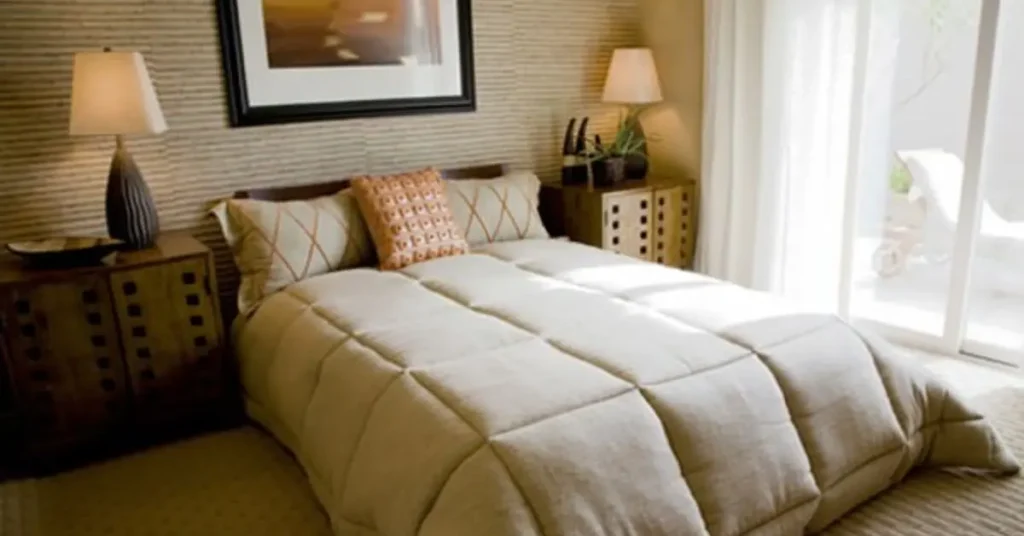
Understanding Bedroom Energy in Feng Shui
The Yin Nature of Bedroom Spaces
In feng shui philosophy, bedrooms should be predominantly yin in nature—calm, peaceful, and restful. Yin energy is characterized by softness, curves, muted colors, and gentle lighting. This contrasts with yang energy, which is active, bright, and stimulating. While yang energy is beneficial in living rooms and offices where we need to be alert and social, too much yang energy in the bedroom can interfere with sleep and relaxation.
Yin Qualities for Bedrooms:
•Soft, muted colors like pastels and earth tones
•Curved furniture and rounded edges
•Gentle, adjustable lighting
•Soft textures and fabrics
•Quiet, peaceful atmosphere
•Minimal electronic devices
Yang Elements to Minimize:
•Bright, stimulating colors like red or orange
•Sharp angles and pointed furniture
•Harsh, bright lighting
•Hard surfaces and materials
•Loud noises or active energy
•Work-related items and electronics
The Flow of Chi in Sleep Spaces
Chi, or life force energy, should flow gently and smoothly through your bedroom, neither rushing too quickly nor becoming stagnant. When chi flows optimally around your sleeping space, it supports deep, restorative sleep and helps your body’s natural healing processes during rest.
Signs of Good Chi Flow:
•You fall asleep easily and sleep deeply
•You wake up feeling refreshed and energized
•The room feels peaceful and comfortable
•Relationships flourish when partners share the space
•You rarely feel restless or anxious in the bedroom
Signs of Poor Chi Flow:
•Difficulty falling asleep or staying asleep
•Waking up tired despite adequate sleep time
•Feeling anxious or uncomfortable in the bedroom
•Relationship tensions that seem worse at bedtime
•Frequent nightmares or disturbing dreams
The Perfect Bed Placement: Command Position Principles
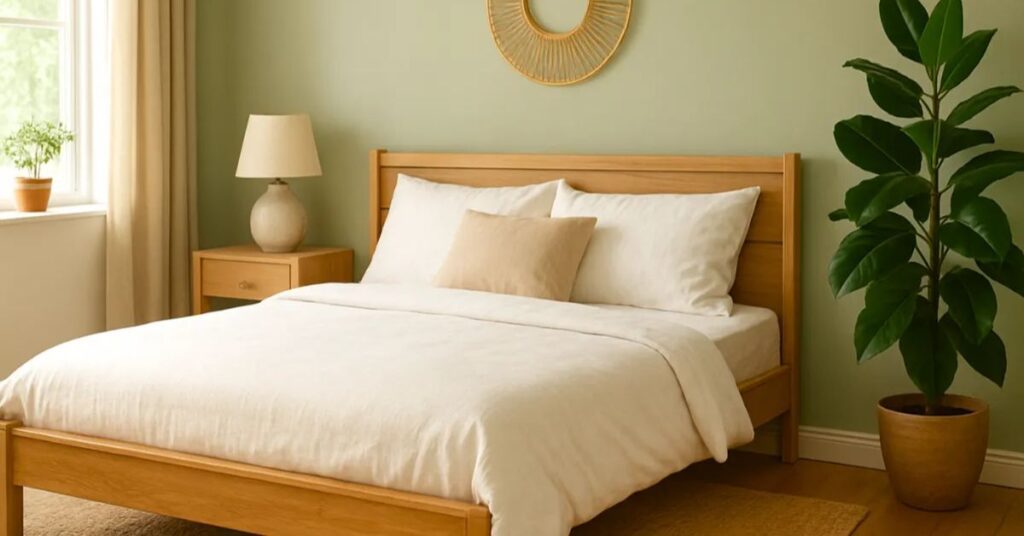
Understanding the Command Position
The most important feng shui principle for bedroom layout is placing your bed in the “command position.” This means positioning your bed so that you can see the bedroom door while lying down, but you’re not directly in line with the door. This placement gives you a sense of security and control over your environment, which is essential for deep, restful sleep.
Command Position Requirements:
•You can see the door from your bed without turning your head significantly
•The bed is not directly aligned with the door (avoiding the “coffin position”)
•There’s a solid wall behind the headboard for support and stability
•You have space to access both sides of the bed when possible
Optimal Bed Placement Strategies
The Diagonal Placement: Position your bed diagonally across from the door, in the corner farthest from the entrance. This placement maximizes the command position while creating the most stable, secure feeling.
The Side Wall Placement: If diagonal placement isn’t possible, position your bed against a side wall where you can still see the door. Ensure the headboard is against a solid wall rather than a window.
Solutions for Challenging Layouts: If your room layout makes command position difficult, use these feng shui remedies:
•Place a mirror where you can see the door’s reflection from bed
•Use a room divider or furniture to create a sense of separation from the door
•Hang a crystal or wind chime between the bed and door to slow rushing energy
What to Avoid in Bed Placement
The Coffin Position: Never place your bed directly in line with the door, as this creates a direct path for energy to rush toward you while sleeping, causing restless sleep and health problems.
Under Windows: Avoid placing the headboard under a window, as this creates instability and allows energy to escape while you sleep. If unavoidable, use heavy curtains or blinds to create a sense of solid support.
Between Door and Window: Don’t position your bed between the door and a window, as this places you in the direct path of energy flow, making restful sleep difficult.
Sharing Walls with Bathrooms: If possible, avoid placing your bed against a wall that’s shared with a bathroom, as the water energy can be disruptive to sleep.
Colors That Promote Rest and Romance
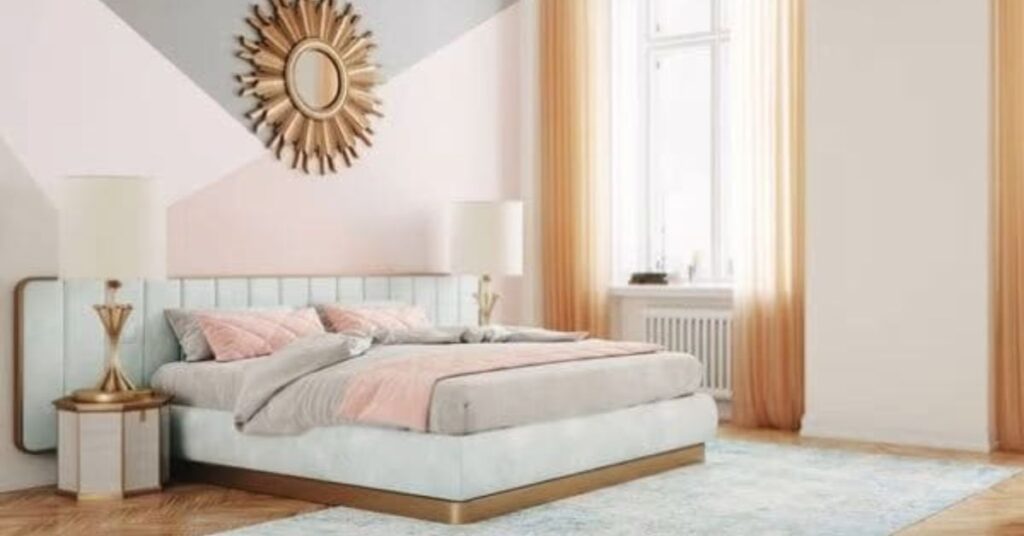
The Psychology and Energy of Bedroom Colors
Color has a profound impact on both our psychological state and the energetic quality of our spaces. In feng shui, different colors correspond to different elements and energies, making color choice crucial for creating the right atmosphere in your bedroom.
Ideal Feng Shui Bedroom Colors
Soft Earth Tones: Beige, warm taupe, and soft browns create grounding, stable energy that promotes security and restful sleep. These colors connect you to earth element energy, which is nourishing and supportive.
Gentle Pastels: Soft pink promotes love and romance, while pale blue encourages tranquility and peace. Light lavender combines the calming qualities of blue with the loving energy of pink.
Muted Greens: Sage green and soft mint create healing, renewal energy while maintaining the calm yin quality essential for bedrooms. Green represents the wood element, which supports growth and new beginnings.
Warm Whites and Creams: Pure white can feel too stark and cold, but warm whites and creams create clean, peaceful energy while maintaining warmth and comfort.
Colors to Use Sparingly or Avoid
Bright Red: While red can enhance passion, too much red in the bedroom creates overstimulating yang energy that interferes with sleep. If you want to incorporate red, use it as small accents rather than dominant colors.
Bright Orange and Yellow: These highly stimulating colors are too yang for bedroom spaces and can cause restlessness and difficulty sleeping.
Dark Colors: While not necessarily harmful, very dark colors like black or deep purple can create heavy, depressing energy if used extensively. Use them as accents rather than primary colors.
Bright Blue: While soft blues are excellent for bedrooms, bright or electric blues can feel too cold and create distance in relationships.
Color Combinations for Different Relationship Goals
For Singles Seeking Love: Combine soft pink with warm cream or beige to create welcoming, loving energy that attracts partnership while maintaining personal comfort.
For Couples Enhancing Romance: Use warm earth tones as a base with soft pink or peach accents to create both stability and romantic energy.
For Better Sleep: Focus on soft blues, lavenders, or sage greens combined with warm neutrals to create maximum tranquility and rest.
Furniture Arrangement for Harmony and Balance
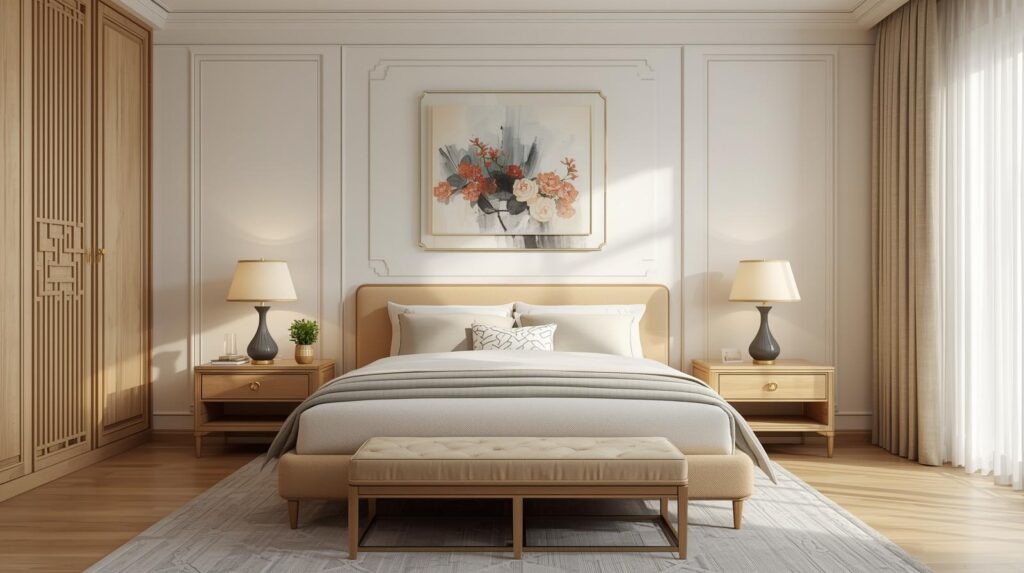
Creating Symmetry and Balance
Feng shui emphasizes the importance of balance and symmetry, especially in bedrooms where partnership energy is important. Even if you’re single, creating balanced arrangements leaves energetic space for a partner to enter your life.
Nightstand Placement: Use matching nightstands on both sides of the bed, positioned at equal distances from the headboard. This creates visual and energetic balance while providing practical storage for both partners.
Lighting Balance: Place matching lamps on both nightstands to create symmetrical lighting. This not only looks harmonious but also ensures both sides of the bed have adequate light for reading or other activities.
Equal Access: Ensure there’s equal space for movement on both sides of the bed. This practical consideration also creates energetic balance and shows the universe you’re open to partnership.
Dresser and Storage Placement
Mirror Considerations: If your dresser has a mirror, avoid positioning it where it reflects the bed directly. Mirrors in bedrooms can create restless energy and are thought to invite third-party energy into relationships. If you must have a mirror in the bedroom, position it where it doesn’t reflect the sleeping area.
Storage Solutions: Keep bedroom storage organized and clutter-free. Closed storage is preferable to open shelving, which can create visual chaos and disturb peaceful energy. Ensure dresser drawers close properly and don’t stick, as this can symbolically represent obstacles in your life.
Clothing and Personal Items: Avoid leaving clothes scattered around the bedroom, as this creates chaotic energy. Use a hamper or designated area for dirty clothes, and keep clean clothes properly stored in closets or dressers.
Creating Clear Pathways
Traffic Flow: Arrange furniture so there are clear, unobstructed pathways around the bed and to the door. Avoid creating narrow passages that force you to squeeze between furniture, as this can create feelings of restriction and limitation.
Under-Bed Space: Keep the area under your bed clear of clutter to allow energy to flow freely around you while you sleep. If you must store items under the bed, choose soft items like extra linens rather than hard objects or anything related to work or stress.
What to Keep OUT of Your Bedroom
Electronics and EMF Considerations
Modern bedrooms are often filled with electronic devices that can interfere with both sleep quality and feng shui energy flow. While it may not be practical to eliminate all electronics, minimizing them can significantly improve your bedroom’s energy.
Television Placement: If you must have a TV in the bedroom, avoid placing it where you can see it from bed, as this can interfere with sleep and intimate connection. Consider mounting it in an armoire or using a decorative screen to cover it when not in use.
Computers and Work Devices: Keep laptops, tablets, and work-related electronics out of the bedroom entirely if possible. These devices carry work energy and electromagnetic fields that can interfere with rest and relaxation.
Phone Charging Stations: Avoid charging phones on nightstands next to your head. If you must keep your phone in the bedroom, place it across the room and use airplane mode or do-not-disturb settings during sleep hours.
EMF Reduction Strategies:
•Unplug electronic devices when not in use
•Use battery-powered alarm clocks instead of electric ones
•Keep Wi-Fi routers away from bedrooms
•Consider EMF-blocking fabrics for window treatments if you live near cell towers
Work-Related Items and Stress
Home Office Separation: Never use your bedroom as a home office or workspace. Work energy is yang and active, directly opposing the yin, restful energy needed for sleep. If space limitations require a desk in your bedroom, use a screen or curtain to separate the work area from the sleeping area.
Bills and Financial Documents: Keep bills, financial statements, and other stress-inducing paperwork out of the bedroom. These items carry worry energy that can interfere with peaceful sleep.
To-Do Lists and Reminders: Avoid keeping calendars, to-do lists, or reminder notes visible in the bedroom, as these create mental stimulation and prevent the mind from settling into rest mode.
Exercise Equipment and Active Energy
Workout Equipment: Exercise equipment carries active, yang energy that’s inappropriate for bedroom spaces. If you must store exercise equipment in your bedroom due to space constraints, cover it with a beautiful cloth when not in use to minimize its energetic impact.
Sports Equipment: Similarly, sports equipment and athletic gear should be stored elsewhere, as they carry competitive, active energy that can interfere with rest and intimacy.
Enhancing Romance and Relationships
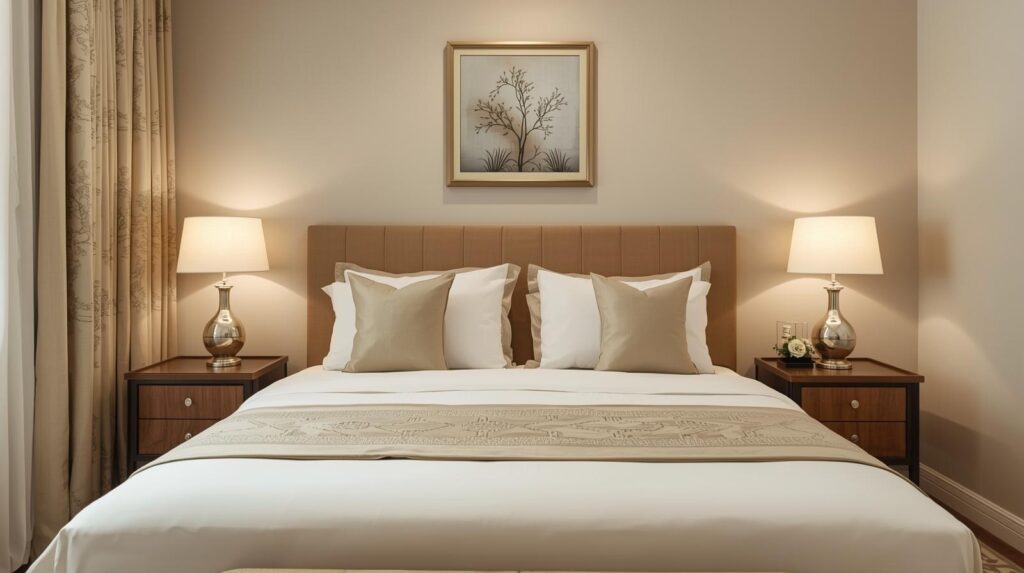
Creating Pairs and Symmetry
Decorative Objects: Use pairs of decorative objects throughout the bedroom to symbolize partnership and balance. This might include pairs of candles, matching picture frames, or twin decorative pillows.
Artwork Selection: Choose artwork that depicts pairs, love, or beautiful natural scenes. Avoid images of single figures, as these can symbolically represent solitude. Also avoid family photos in the bedroom, as these can interfere with romantic intimacy.
Fresh Flowers: Place fresh flowers in pairs of vases or choose arrangements that include even numbers of stems. Peonies are particularly auspicious for love and romance in feng shui tradition.
Crystal Recommendations for Love

Rose Quartz: Known as the stone of unconditional love, rose quartz can be placed on nightstands or in the relationship corner of the bedroom (the far right corner from the entrance) to enhance loving energy.
Rhodonite: This pink and black stone helps heal emotional wounds and promotes forgiveness, making it excellent for couples working through relationship challenges.
Green Aventurine: While primarily known for luck and prosperity, green aventurine also supports emotional healing and can help create harmony in relationships.
Placement Guidelines: Place love crystals in pairs when possible, and cleanse them regularly under moonlight to maintain their positive energy. Avoid placing crystals directly on the bed, as they can be too stimulating for sleep.
Creating Intimate Lighting
Layered Lighting Options: Install dimmer switches or use multiple light sources at different levels to create adjustable ambiance. This allows you to have bright light for practical activities and soft light for relaxation and romance.
Candle Safety: Candles create beautiful romantic ambiance, but always use them safely. Place them in stable holders away from curtains and bedding, and never leave them unattended. Consider LED candles for safer ambient lighting.
Natural Light Management: Use curtains or blinds that allow you to control natural light throughout the day. Blackout curtains can improve sleep quality, while sheer curtains maintain privacy while allowing gentle natural light.
Quick Bedroom Feng Shui Transformation Checklist
15-Minute Immediate Improvements
Clear the Clutter: Spend 5 minutes removing any items that don’t belong in the bedroom, including work materials, exercise equipment, and unnecessary electronics.
Make the Bed: Always make your bed each morning, as this simple act creates order and positive energy for the entire day.
Check Your View: Ensure you can see the bedroom door from your bed. If not, adjust the bed position or add a mirror to create visibility.
Balance the Nightstands: Make sure both nightstands have similar items and that the arrangement feels balanced and symmetrical.
Adjust the Lighting: Replace harsh bulbs with softer ones, or add a lamp if the room feels too dark. Ensure you have adjustable lighting options.
Essential Changes for Better Sleep
Bed Position Optimization: If your bed isn’t in command position, rearrange the room to achieve this placement. This single change can dramatically improve sleep quality and feelings of security.
Color Assessment: Look at your bedroom colors and remove or replace any items in overstimulating colors like bright red, orange, or electric blue.
Electronic Minimization: Remove or relocate as many electronic devices as possible, especially those near the bed or that emit light during sleep hours.
Under-Bed Clearing: Remove all items from under your bed to allow energy to flow freely around you while sleeping.
Monthly Maintenance Routine
Energy Refresh: Open windows for fresh air circulation and consider burning sage or palo santo to clear stagnant energy.
Crystal Cleansing: If you use crystals in your bedroom, cleanse them monthly under moonlight or with sage smoke to maintain their positive energy.
Relationship Assessment: Evaluate how your bedroom arrangement is supporting your relationship goals and make adjustments as needed.
Seasonal Updates: Adjust colors, textures, and decorative elements to align with seasonal energy changes while maintaining the bedroom’s peaceful yin nature.
Advanced Feng Shui Bedroom Techniques
Personal Direction Alignment
In advanced feng shui practice, each person has favorable sleeping directions based on their birth date and gender. While the command position takes priority, you can fine-tune your bed placement to align with your personal favorable directions when possible.
Calculating Your Directions: Traditional feng shui uses complex calculations to determine personal directions, but many online calculators can help you identify your favorable sleeping directions based on your birth year.
Balancing Priorities: If your favorable direction conflicts with command position, prioritize command position for security and adjust other elements to enhance the energy.
Seasonal Bedroom Adjustments
Spring Energy (Wood Element): Add fresh flowers, green accents, and open windows more frequently to welcome renewal energy while maintaining bedroom tranquility.
Summer Energy (Fire Element): Use minimal fire element additions like a single red accent pillow, but avoid overstimulating the space with too much fire energy.
Autumn Energy (Metal Element): Incorporate white or cream linens and perhaps a small metal decorative object, while maintaining the soft, yin atmosphere.
Winter Energy (Water Element): Add deeper blues or a small water feature like a tabletop fountain, but ensure it doesn’t create too much active energy for sleep.
Addressing Specific Sleep Challenges
For Insomnia: Focus on maximizing yin energy with soft colors, gentle lighting, and minimal stimulation. Remove all electronics and ensure the room is as dark and quiet as possible during sleep hours.
For Nightmares: Place protective crystals like black tourmaline or amethyst near the bed, ensure the bed is in strong command position, and avoid mirrors reflecting the sleeping area.
For Relationship Issues: Emphasize pairs of objects, soft pink accents, and ensure equal access and space on both sides of the bed. Remove any artwork depicting solitary figures.
Your Journey to Better Sleep Starts Tonight
Creating a feng shui bedroom is one of the most impactful changes you can make for your overall well-being. By applying these principles, you’re not just rearranging furniture—you’re creating an environment that actively supports your health, relationships, and personal growth. The bedroom is where we’re most vulnerable, spending hours in rest and renewal, making it crucial that this space feels safe, peaceful, and harmonious.
Remember that feng shui is both an art and a science. While these guidelines provide a strong foundation, trust your intuition about what feels right in your space. Start with the most important changes—bed placement, clutter clearing, and color adjustments—and gradually refine your bedroom’s energy over time.
The benefits of a well-arranged feng shui bedroom often become apparent quickly. Many people report better sleep quality within the first few nights, while relationship improvements and overall well-being may develop over weeks or months. Be patient with the process and pay attention to how the changes affect your sleep, dreams, and daily energy levels.
Your bedroom should be your sanctuary, a place where you feel completely safe, relaxed, and restored. When your sleeping space is arranged according to feng shui principles, it becomes a powerful ally in creating the life you desire—supporting your health, nurturing your relationships, and providing the deep rest necessary for success in all areas of life.
For comprehensive guidance on applying feng shui principles throughout your entire home, including advanced bedroom techniques and room-by-room arrangements, explore our complete feng shui guide for beginners. Transform not just your bedroom, but your entire living space into a sanctuary of harmony and positive energy.
Sweet dreams and harmonious living await in your newly balanced bedroom sanctuary.
References
Collins, Terah Kathryn. “The Western Guide to Feng Shui: Room by Room.” Hay House, 1999.
National Sleep Foundation. “Bedroom Environment.” https://www.sleepfoundation.org/bedroom-environment
Wong, Eva. “Feng Shui: The Ancient Wisdom of Harmonious Living.” Shambhala Publications, 1996.
